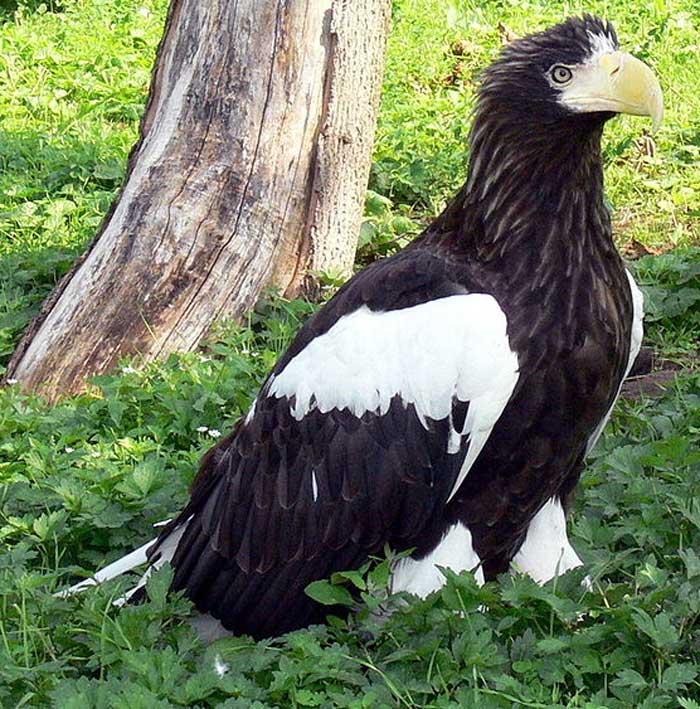Haliaeetus pelagicus (*) Cladus: Eukaryota Name Haliaeetus pelagicus (Pallas, 1811) Reference * Zoographia Rosso-Asiatica 1 p.343 pl.
The Steller's Sea Eagle, Haliaeetus pelagicus,[2] is a large bird of prey in the family Accipitridae. It lives in coastal northeastern Asia and mainly preys on fish. It is, on average, the heaviest eagle in the world, at about 4.9 to 9 kilograms (11 to 20 lb; 0.77 to 1.4 st), but often lags behind the Harpy Eagle and Philippine Eagle in other measurements.[3] This bird is named after the German naturalist Georg Wilhelm Steller.[4] Description, systematics, and status
Two subspecies have been named: The relatively widespread nominate pelagicus and the virtually unknown H. p. niger.[5] The latter name was given to the population which lacked white feathers except for the tail and supposedly was resident all year in Korea. Last seen in 1968 and long believed to be extinct, a female matching H. p. niger in appearance was born in captivity in 2001. Both its parent were "normal" in appearance, indicating that H. p. niger is an extremely rare morph rather than a valid subspecies, as had already been suggested earlier.[6][7] The relationships of Steller's Sea-eagle are not completely resolved. mtDNA cytochrome b sequence data tentatively suggests that this species's ancestors diverged early in the colonization of the Holarctic by sea eagles. This is strongly supported by morphological traits such as the yellow eyes, beak, and talons shared by this species and the other northern sea-eagles, the White-tailed and Bald Eagles, and biogeography.[8] Distribution and habitat Steller's Sea Eagle breeds on the Kamchatka Peninsula, the coastal area around the Sea of Okhotsk, the lower reaches of the Amur river and on northern Sakhalin and the Shantar Islands, Russia. The majority of birds winter further south, in the southern Kuril islands, Russia and Hokkaidō, Japan. That being said, the Steller's Sea-eagle is less vagrant than the White-tailed Eagle, usually lacking the long-range dispersal common in juveniles of that species. The large size (see also Bergmann's Rule) suggests that it is a glacial relict, meaning that it evolved in a narrow subarctic zone of the northeasternmost Asian coasts, which shifted its latitude according to ice age cycles, and never occurred anywhere else. It is unique among all sea eagles in having a yellow bill even in juvenile birds, and possessing 14, not 12, rectrices. The skull and bill are the largest of any eagle and comparable to the largest Old World vultures, the biggest accipitrids.[9] The birds have been found in North America but this are considered to be individual eagles that have strayed from Asia, and they are not known to nest anywhere in North America. This species is classified as Vulnerable. The main threats to its survival are habitat alteration, industrial pollution and over-fishing. The current population is estimated at 5,000 and decreasing.[1]
The Steller's Sea-eagle mainly feeds on fish. Favored prey include salmon (Onchorhynchus spp.), trout and cod.[10] Besides fish, it also preys on water-dwelling birds (including ducks, geese, swans, cranes and gulls), various mammals, crabs, squid and carrion.[11] This eagle may prey on young seals, but seals are generally more likely to be eaten as carrion. Reproduction This eagle builds several aeries (height, 150 cm; diameter up to 250 cm) high up on trees and rock. It is possible that the eagles change occasionally between these nests. After courtship, which usually occurs between February and March, the animals lay their first white-green eggs around April to May. Usually only one chick survives. After an incubation period of around 39 – 45 days the chicks hatch, having ash grey to white down. As young birds the down changes to brown feathers and at an age of around ten weeks, the young birds learn to fly. They reach sexual maturity at around four to five years. Full adult plumage in the Steller's Sea Eagle only appears at age eight to ten years. Eggs and nestlings can be preyed on by arboreal mammals, such as martens, and birds, usually corvids. Once fully grown, the eagle has no natural predators.[12] References 1. ^ a b BirdLife International (2008). Haliaeetus pelagicus. In: IUCN 2010. IUCN Red List of Threatened Species. Version Version 2010.3. Downloaded on 26 October 2010.
Source: Wikipedia, Wikispecies: All text is available under the terms of the GNU Free Documentation License |
|

